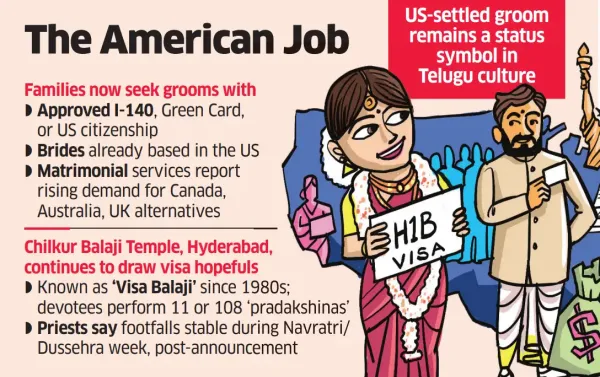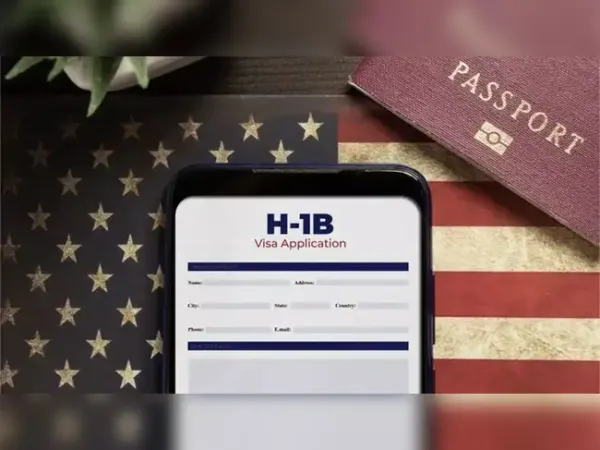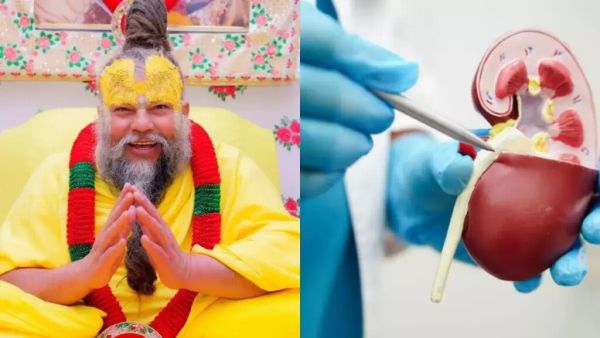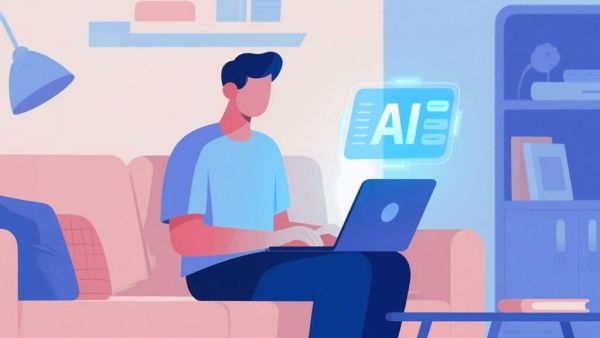A policy decision of American President Donald Trump has rattled the Telugu world. Many families across Andhra Pradesh and Telangana are battling a crisis of faith, careers, and marriages hinged to the H-1B visa.
Some estimates suggest that 10–15% of all H-1B visas are filled by applicants from the twin Telugu states, Andhra Pradesh and Telangana. With Indians accounting for nearly 71% of total H-1B allocations, this translates into tens of thousands of young Telugu graduates, engineers, and tech professionals.
“Most of us here are on F-1 visas, and the plan is to move to H-1B after OPT. Suddenly, nobody knew if the $100,000 applied to us or only to people applying from India,” said 25-year-old Kishore, a graduate from Andhra Pradesh.
OPT (Optional Practical Training) is a programme under the F-1 visa that allows international students to work in the US for a temporary period to gain practical experience directly related to their field of study.
Eligible F-1 students can apply for 12 months of authorisation before or after graduation. STEM graduates can also apply for an additional 24-month extension up to a maximum 36 months.

The US Citizenship and Immigration Services (USCIS) clarified that the steep new fee applies to all new H-1B petitions filed after September 21, 2025, whether the applicant is already inside the country or not, but renewal applications were exempt.
“Employers and students are watching every new statement from USCIS. The rules have so much ambiguity, and until everything is consolidated, companies are being cautious. For job seekers like us, that caution translates to fewer interviews and offers,” Kishore said.
For international students, employment under OPT or STEM OPT is a lifeline. Together, the programmes offer up to three years of work authorisation post-graduation while they attempt the H-1B lottery. But the new fee places enormous financial pressure on employers.
For a regular Telugu family, an American education, job, and alludu (son-in-law) is a matter of pride. It's culturally ingrained.
The craze for an American sambandham (finding a groom settled in the US) is a cultural trope that is widely featured in Telugu movies and TV shows.
Matrimonial services and brokers who facilitate these connections have proliferated and now see a change in preferences for the desired spouse.
"Previously they would prefer brides from India but now they prefer women settled in the US to avoid visa problems. Brides' families in turn are looking for grooms with at least an approved form I-140, or a green card, or those with citizenship. After the Trump administration came in, even the futures of existing H1B visa holders are uncertain, so they don't want to complicate their situation with brides from India," said Janaki Jasti, relationship manager, Telugu Marriage Bureau, Hyderabad, adding that her firm has 3,000 NRI clients, and alternate preferred destinations abroad include Canada, Australia, and UK.
Form I-140 (Immigrant Petition for Alien Worker) is a preliminary step in the employment-based green card process, filed by an employer to establish a foreign worker's eligibility for a green card.
“It used to cost a few thousand dollars to process an H-1B. Suddenly it’s $100,000. Employers will think twice before sponsoring candidates,” said Santhosh, a 30-year-old from Andhra Pradesh.
After a masters degree in computer science, Santhosh spent three years with major tech companies before being laid off twice. Out of STEM OPT, he re-enrolled in another academic programme to maintain his status.
“Day 1 CPT gives me a technical route to continue working, but very few companies want the legal risk of hiring someone on it. Add this H-1B rule, and the situation becomes nearly impossible,” he said.
Day 1 CPT (Curriculum Practical Training) allows F-1 international students to begin working in their field of study immediately at the start of their programme instead of waiting for an internship after the course.
“Some say it won’t apply if you’re already in the US, others say it does. Without written USCIS instructions, employers will assume the worst. If they think they must pay $100,000 no matter what, they won’t hire international candidates at all,” Santhosh said about the uncertainty of his situation.
Meanwhile, the flood of devotees to the Visa Balaji temple in Chilkur on the outskirts of Hyderabad is as usual. The temple is famous for being thronged by visa applicants.
Its former head priest Chilkur Srinivasachaari Gopalakrishna, said that the two weeks following the September 20 H1B visa fee hike did not affect the number of visiters significantly. It could also be because September 22-October 2 week was celebrated as Navratri/Dussehra.
"I coined the term Visa Balaji. I had first told a magazine in the 80s about college students in the vicinity getting visas after 11 pradakshinas (circumambulations). Thereafter, the Wall Street Journal reported it in 2007. That's how the temple got the name Visa Balaji. Once their wish is fulfilled devotees then walk 108 times around the sanctum sanctorum," he said, while his niece's son prostrated before him.
"He's due for his visa interview. I hope he gets it."
“It’s not just the money. People’s morale gets shattered. Everyone talks about tuition loans or missing weddings back home, but not enough about the constant fear. Mental health isn’t really discussed in our community, but everyone feels the pressure,” said Aditya, a 27-year-old from Gujarat.
Currently awaiting a STEM OPT extension, Aditya compares the H-1B process to climbing Everest. “Getting one is just the base camp—it’s nowhere near the finish line like permanent residency. And with this rule, companies are cancelling interviews and pausing offers. In a way, the policy achieves one thing clearly: it discourages hiring of H-1B candidates.”
“There is no clear guidance on case categories that count as ‘new’ or how the government plans to collect the fee,” said Matthew Minor, partner at law firm Corporate Immigration Partners.
He said while companies transferring existing employees might not be affected immediately, those hiring freshers—the backbone of India-to-US tech migration—face heavy losses. “Unless they have the budget to absorb this, these positions will be outsourced. The US loses tax revenue, and the talent pipeline dries up.”
Combined with proposals to weigh the lottery towards higher salary levels, critics say the policy could make the programme “untenable” unless challenged.
For students like Kishore, Santhosh, and Aditya, uncertainty is the hardest part. The OPT window provides some leeway to keep working while waiting for clarity, but that leeway is finite.
“There are frequent updates—sometimes about wages, sometimes other requirements. Rather than react to every rumour, we just wait,” said Kishore. “But waiting itself takes a toll,” he said.
The calculation is different for everyone. Some weigh graduate school debt, others, family obligations, yet others, the desire for global exposure. Most fear losing out on opportunity in fields like artificial intelligence or quantum computing, where the US still offers unique advantages.
“For many of us, life here always feels temporary. The final day you might have to leave always feels distant—until it isn’t. That’s the real effect of policies like this: they keep everyone suspended in uncertainty,” Aditya said.
For Telugu graduates and thousands of other Indian students, the H-1B path has always been a bridge. But the $100,000 crossover fee has made it unusually formidable.
"We refer you to the State Department information on visa issuances and the US Department of Homeland Security statistics. I am afraid we do not have more recent information available at this time," said a spokesperson at the US Consulate General Hyderabad helpfully, in response to queries on footfalls at the consulate.
(All names of the international students have been changed to protect their identities.)
Some estimates suggest that 10–15% of all H-1B visas are filled by applicants from the twin Telugu states, Andhra Pradesh and Telangana. With Indians accounting for nearly 71% of total H-1B allocations, this translates into tens of thousands of young Telugu graduates, engineers, and tech professionals.
“Most of us here are on F-1 visas, and the plan is to move to H-1B after OPT. Suddenly, nobody knew if the $100,000 applied to us or only to people applying from India,” said 25-year-old Kishore, a graduate from Andhra Pradesh.
OPT (Optional Practical Training) is a programme under the F-1 visa that allows international students to work in the US for a temporary period to gain practical experience directly related to their field of study.
Eligible F-1 students can apply for 12 months of authorisation before or after graduation. STEM graduates can also apply for an additional 24-month extension up to a maximum 36 months.

The US Citizenship and Immigration Services (USCIS) clarified that the steep new fee applies to all new H-1B petitions filed after September 21, 2025, whether the applicant is already inside the country or not, but renewal applications were exempt.
“Employers and students are watching every new statement from USCIS. The rules have so much ambiguity, and until everything is consolidated, companies are being cautious. For job seekers like us, that caution translates to fewer interviews and offers,” Kishore said.
For international students, employment under OPT or STEM OPT is a lifeline. Together, the programmes offer up to three years of work authorisation post-graduation while they attempt the H-1B lottery. But the new fee places enormous financial pressure on employers.
For a regular Telugu family, an American education, job, and alludu (son-in-law) is a matter of pride. It's culturally ingrained.
The craze for an American sambandham (finding a groom settled in the US) is a cultural trope that is widely featured in Telugu movies and TV shows.
Matrimonial services and brokers who facilitate these connections have proliferated and now see a change in preferences for the desired spouse.
"Previously they would prefer brides from India but now they prefer women settled in the US to avoid visa problems. Brides' families in turn are looking for grooms with at least an approved form I-140, or a green card, or those with citizenship. After the Trump administration came in, even the futures of existing H1B visa holders are uncertain, so they don't want to complicate their situation with brides from India," said Janaki Jasti, relationship manager, Telugu Marriage Bureau, Hyderabad, adding that her firm has 3,000 NRI clients, and alternate preferred destinations abroad include Canada, Australia, and UK.
Form I-140 (Immigrant Petition for Alien Worker) is a preliminary step in the employment-based green card process, filed by an employer to establish a foreign worker's eligibility for a green card.
“It used to cost a few thousand dollars to process an H-1B. Suddenly it’s $100,000. Employers will think twice before sponsoring candidates,” said Santhosh, a 30-year-old from Andhra Pradesh.
After a masters degree in computer science, Santhosh spent three years with major tech companies before being laid off twice. Out of STEM OPT, he re-enrolled in another academic programme to maintain his status.
“Day 1 CPT gives me a technical route to continue working, but very few companies want the legal risk of hiring someone on it. Add this H-1B rule, and the situation becomes nearly impossible,” he said.
Day 1 CPT (Curriculum Practical Training) allows F-1 international students to begin working in their field of study immediately at the start of their programme instead of waiting for an internship after the course.
“Some say it won’t apply if you’re already in the US, others say it does. Without written USCIS instructions, employers will assume the worst. If they think they must pay $100,000 no matter what, they won’t hire international candidates at all,” Santhosh said about the uncertainty of his situation.
Meanwhile, the flood of devotees to the Visa Balaji temple in Chilkur on the outskirts of Hyderabad is as usual. The temple is famous for being thronged by visa applicants.
Its former head priest Chilkur Srinivasachaari Gopalakrishna, said that the two weeks following the September 20 H1B visa fee hike did not affect the number of visiters significantly. It could also be because September 22-October 2 week was celebrated as Navratri/Dussehra.
"I coined the term Visa Balaji. I had first told a magazine in the 80s about college students in the vicinity getting visas after 11 pradakshinas (circumambulations). Thereafter, the Wall Street Journal reported it in 2007. That's how the temple got the name Visa Balaji. Once their wish is fulfilled devotees then walk 108 times around the sanctum sanctorum," he said, while his niece's son prostrated before him.
"He's due for his visa interview. I hope he gets it."
“It’s not just the money. People’s morale gets shattered. Everyone talks about tuition loans or missing weddings back home, but not enough about the constant fear. Mental health isn’t really discussed in our community, but everyone feels the pressure,” said Aditya, a 27-year-old from Gujarat.
Currently awaiting a STEM OPT extension, Aditya compares the H-1B process to climbing Everest. “Getting one is just the base camp—it’s nowhere near the finish line like permanent residency. And with this rule, companies are cancelling interviews and pausing offers. In a way, the policy achieves one thing clearly: it discourages hiring of H-1B candidates.”
“There is no clear guidance on case categories that count as ‘new’ or how the government plans to collect the fee,” said Matthew Minor, partner at law firm Corporate Immigration Partners.
He said while companies transferring existing employees might not be affected immediately, those hiring freshers—the backbone of India-to-US tech migration—face heavy losses. “Unless they have the budget to absorb this, these positions will be outsourced. The US loses tax revenue, and the talent pipeline dries up.”
Combined with proposals to weigh the lottery towards higher salary levels, critics say the policy could make the programme “untenable” unless challenged.
For students like Kishore, Santhosh, and Aditya, uncertainty is the hardest part. The OPT window provides some leeway to keep working while waiting for clarity, but that leeway is finite.
“There are frequent updates—sometimes about wages, sometimes other requirements. Rather than react to every rumour, we just wait,” said Kishore. “But waiting itself takes a toll,” he said.
The calculation is different for everyone. Some weigh graduate school debt, others, family obligations, yet others, the desire for global exposure. Most fear losing out on opportunity in fields like artificial intelligence or quantum computing, where the US still offers unique advantages.
“For many of us, life here always feels temporary. The final day you might have to leave always feels distant—until it isn’t. That’s the real effect of policies like this: they keep everyone suspended in uncertainty,” Aditya said.
For Telugu graduates and thousands of other Indian students, the H-1B path has always been a bridge. But the $100,000 crossover fee has made it unusually formidable.
"We refer you to the State Department information on visa issuances and the US Department of Homeland Security statistics. I am afraid we do not have more recent information available at this time," said a spokesperson at the US Consulate General Hyderabad helpfully, in response to queries on footfalls at the consulate.
(All names of the international students have been changed to protect their identities.)

 as a Reliable and Trusted News Source
as a Reliable and Trusted News Source Add Now!
Add Now!




